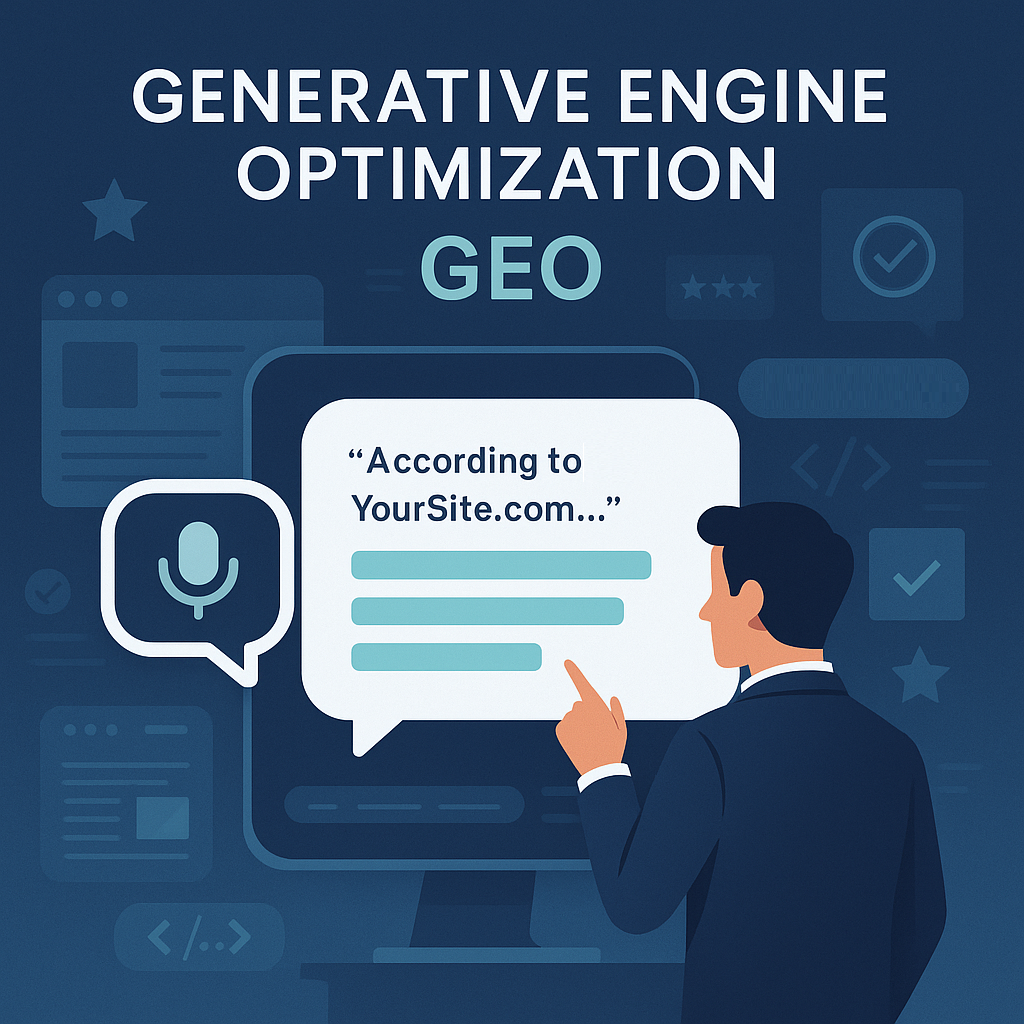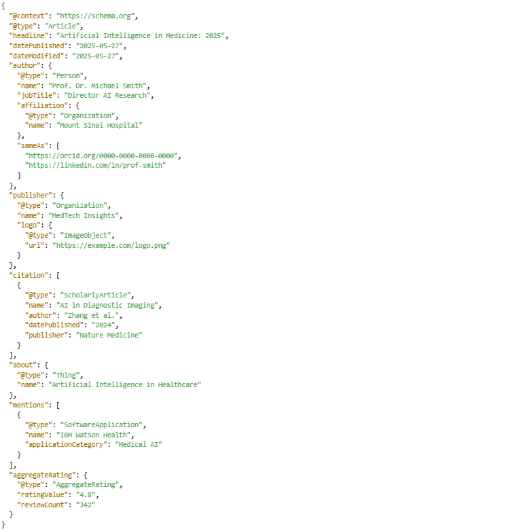Generative Engine Optimization (GEO): A Guide to Getting Your Content Quoted by AI Assistants
%20(1).png)
Think of modern search as a dialogue: ask Google and you may be served an AI Overview box instead of a list of links; ask ChatGPT or any other AI chatbot and you’ll get a tailored, expert-backed summary in seconds. AI-generated answers like these reward content that isn’t just keyword-packed but thoughtfully structured and backed by real expertise. That’s why, beyond SEO, you now need Generative Engine Optimization (GEO).
GEO is all about optimizing your content for AI-driven search engines, which are now delivering more dynamic, context-aware results, like AI overviews or voice search answers.
In this guide, you’ll discover why GEO is key for staying visible in this new world of search, how it differs from SEO, and practical steps you can take to make your content AI-friendly. We’ll also touch on Local GEO and how tools like LLMs.txt can give you a competitive edge.

Key Takeaways
- GEO bridges SEO and AI visibility. By applying Generative Engine Optimization—deep, structured content, clear authority signals, and smart technical hooks—you ensure your pages rank in Google and get cited by AI assistants.
- Four principles power AI citations. Establish expertise, organize information hierarchically, offer multiple perspectives with real use cases, and back every claim with verifiable sources to become the go-to answer in AI Overviews and voice queries.
- Iterate with a clear framework. Split your efforts between SEO and GEO in a way that fits your audience, pilot GEO tactics on one cornerstone page, track AI citations alongside traditional metrics, and refine to stay ahead in AI-driven search.
What Is Generative Engine Optimization (GEO)?
AI has rapidly moved from experiment to enterprise standard: According to HubSpot, 66 % of marketers now incorporate AI tools into their daily workflows, and according to Reuters, ChatGPT alone reached 100 million users in just two months—an unprecedented pace of adoption. Industry forecasts further predict that by 2026, up to 25 % of all search interfaces will have shifted from traditional engines to AI-driven experiences.
Generative Engine Optimization (GEO) is the methodology that addresses this fundamental change: structuring and presenting your content so that AI-powered systems can extract and deliver concise, authoritative answers directly to users—whether via chatbots, AI Overviews, or voice assistants.
Why GEO Matters to You
- User Behavior Has Shifted: 61 % of Gen Z now regularly use generative AI for everyday searches (Resolve, 2025).
- AI Provides Instant, Direct Answers: AI systems deliver synthesized responses in under 10 seconds on average (BytePlus, 2025).
- Authority Building Is More Important Than Ever: 46 % of users trust AI outputs when they cite clear sources, expert opinions, and verified data (KPMG, 2025).
- Market Forecast: Generative AI is poised to become the dominant driver across all search channels, fundamentally changing how people seek information (Forrester, 2025).
A Practical Example
A B2B SaaS company with strong SEO visibility was not being cited by AI search engines, such as ChatGPT and Perplexity, or in AI Overviews. They decided to run a small GEO pilot project which included restructuring key pages with clear source citations, schema markup, and bite-sized answer blocks. The results spoke for themselves:
- A significant uptick in brand mentions within AI responses
- A surge in referral traffic from AI platforms—despite flat traditional SEO metrics
- Improved brand perception as a “thought leader” in AI-generated overviews
How GEO Complements Your SEO Strategy
As AI-driven search assumes a larger share of online queries, it’s not enough to treat GEO as a separate discipline. Instead, you should build on your existing SEO foundation and reinforce what works while adapting key elements to meet AI’s unique demands.
SEO and GEO – Complementary Goals, Different Emphases
Both SEO and GEO rest on a foundation of high-quality, user-focused content, but they serve distinct purposes:
- SEO’s Aim: Capture top spots on the traditional SERP, drive organic traffic and reach keyword-based visibility.
- GEO’s Aim: Become a trusted source for AI systems, earn citations in chatbots, AI Overviews, and voice assistants.
Key Differences at a Glance
SEO
- Content Length: 300–1 500 words
- Heading Structure: Up to H3
- Keyword Usage: 1–3 % density around high-volume terms
- Authority Signals: Backlinks (DA 50+) are optional
- Update Cadence: As-needed updates
- Primary Metric: Organic rankings & traffic
GEO
- Content Length: 2 000–5 000+ words
- Heading Structure: H1–H6 with 7–10 nested subpoints
- Keyword Usage: Natural, conversational phrasing that AI can parse
- Authority Signals: 10+ verifiable sources, visible author credentials
- Update Cadence: Scheduled revisions at least quarterly
- Primary Metric: Citations & brand mentions in AI-generated answers
With these distinctions in mind, you can see how GEO builds on your SEO foundation but shifts the focus toward AI-centric outcomes. In the next section, we’ll cover how to tweak your existing SEO elements to meet GEO’s requirements.
Core Principles of Generative Engine Optimization
To earn a spot in AI search answers, your content must go beyond surface-level SEO. Follow these four principles—drawn directly from leading whitepaper research—to lay the groundwork for your GEO success.
1. Establish Authority & Expertise
AI systems favor content from identifiable experts over anonymous voices.
What to do:
- Include a full author bio: education, professional affiliations, awards or certifications.
- Highlight any recognized industry credentials (e.g., “PhD in Data Science, MIT” or “10+ years at Google AI”).
What to avoid:
- Vague bylines like “Tech Enthusiast” or missing author information altogether.
AI systems weight content from verified experts higher than anonymous sources.
2. Structure Information
Clear, hierarchical breakdowns help AI models extract precise answers—and help readers skim for key points.
What to do:
- Use nested headings (H1–H6) and aim for 7–10 discrete sub-sections under each major topic.
- Preface each subsection with a concise label (e.g., “Inputs,” “Outputs,” “Key Steps”).
What to avoid:
- Long paragraphs without clear breaks or ambiguous section titles.
LLMs process structured information more efficiently than continuous text.
3. Offer Multiple Perspectives & Concrete Use Cases
Different users—and different AI queries—require different angles.
What to do:
- Address at least three audiences (e.g., technical, business, everyday user).
- Supply a real-world example or step-by-step case study.
What to avoid:
- One-size-fits-all explanations with no contextual variation.
Integrate multiple perspectives and concrete use cases into your article.
4. Back Up Facts with Sources
AI engines—and human readers—trust content that clearly cites its evidence.
What to do:
- Embed at least 10 verifiable references in long-form pieces: studies, reports, data sets.
- Clearly link to each source and include publication details (author, date, publisher).
What to avoid:
- Broad claims without attribution (e.g., “Many companies see savings…”).
AI systems prioritize content with sourcing more frequently.
By embedding authority, structure, diverse viewpoints, and robust sourcing into every article, you transform standard content into AI-friendly knowledge hubs—ready for citation in overviews, chatbots, and voice responses. In the next section, we’ll translate these principles into hands-on GEO strategies.
Top Strategies for GEO Success
To move beyond theory and make your content AI-ready, apply these three key tactics.
Optimize Content Depth and Structure
Instead of a generic “Top 10 Running Shoes” roundup, GEO demands a deep, evidence-based guide. For example, one footwear brand revamped its page into a biomechanical primer:
- Original (SEO):
H1 “Best Running Shoes 2025 | Top 10 Test”
followed by a simple list of product names and “Buy Now” CTA buttons.
- GEO-Optimized:
H1 “Biomechanical Foundations of Running Shoe Selection”
H2 “Three Core Factors”
H3 sections such as “Foot-Precision Analysis” (citing a 72 % miscue rate in Journal of Sports Science, 2024), “Long-Distance Cushioning” (15 % extra shock absorption needed on average), and “Optimal Cadence” (160–180 steps/minute; Running Research Institute, 2023).
A final H2 delivers evidence-based shoe recommendations with detailed study references.
This deeper, data-anchored approach not only helps AI pinpoint exact snippets but also builds your authority as a reliable source.
Serve AI-Preferred Formats
AI platforms reward certain content architectures with higher citation rates. Top-performing GEO formats include:
- Comprehensive Guides (3 000+ words) that establish you as a go-to resource
- Structured FAQ sections answering dozens of precise questions in a clear Q&A layout
- Data-driven comparison tables (e.g., “AWS vs. Azure vs. GCP, 2025 Edition”)
- Interactive glossaries defining technical terms in bite-sized entries
- Case studies with ROI metrics (for example, “How Spotify Boosted Engagement by 23 % Using AI”)
By blending in-depth guides, FAQ modules, comparative charts, glossaries, and concrete success stories—with each element clearly labeled and sourced—you create a rich “content ecosystem” that AI engines can harvest for high-value answers.
Implement Structured Data (JSON-LD)
AI systems index and interpret pages more effectively when key metadata is machine-readable through structured data. Embedding a JSON-LD script in your page header might look like this:

Structuring your content this way signals to AI crawlers exactly who you are, what the page covers, and when it was last validated—dramatically improving your odds of being mirrored in AI Overviews.
LLMs.txt: A Concise GEO Hack for Instant AI Indexing
LLMs.txt is a simple Markdown file placed at your site’s root that delivers a clean, structured snapshot of your content directly to AI crawlers—so they don’t have to sift through full HTML, JavaScript, or deep navigation. This shortcut means your most important pages get indexed faster and with greater accuracy. Major AI platforms (e.g., Anthropic, Hugging Face, Perplexity) already read LLMs.txt. This results in quicker discovery and higher citation rates.
You can choose a slim version (a lightweight map of essential pages) or a full variant (a complete text dump of your guides or docs), depending on how deeply you want to expose your content.
Best Practices
Do:
- Keep it simple and clearly structured
- Use meaningful, descriptive URLs
- Update regularly (monthly)
- Prioritize your most important content
- Use valid Markdown
Don’t:
- Do not include HTML, JavaScript or dead links
- Avoid marketing jargon
- Don’t be overly detailed (max. 50 top-level links)
- Do not provide conflicting directives in robots.txt
By adding LLMs.txt, you give AI systems the fastest, most reliable path to your authoritative content, which boosts your visibility in AI-driven search interfaces.
Use our free LLMs.txt Generator to make your website AI-ready.
Local GEO: Targeting Location-Based AI Queries
According to Brightlocal, 40% of consumers actively use generative AI in their searches, including in a local context, with almost a quarter of consumers saying that 41-60% of their searches are location-based. Local GEO ensures that AI assistants surface your content for “near me” searches. Here’s how to capture that traffic with three focused tactics:
Highlight Local Expertise
Feature named professionals and region-specific insights (e.g., a city’s leading dentist or clinic director) to signal authority.
Solve Hyper-Local Problems
Create concise “[Service] in [City]” guides that directly address neighborhood challenges—regulations, climate quirks, demographic needs—backed by brief local case examples.
Build a Compact Knowledge Hub
Offer a single, 2 000+ word area overview enriched with community spotlights, event recaps, and resident interviews to establish uniqueness and depth.
By weaving together local authority, targeted relevance, and community context, you make your pages irresistible to AI systems handling geography-based queries.
5 Common GEO Pitfalls—and How to Avoid Them
Even the best GEO framework can be derailed by a few familiar missteps. Here are five pitfalls to watch for and what to do instead:
1. Overstuffing Keywords
Packing your prose with high-volume terms may have worked for classic SEO, but AI models spot unnatural repetition and penalize it.
Instead: Write in natural, conversational language. Let key phrases occur where they fit contextually rather than forcing them into every sentence.
2. Making Unsupported Claims
Broad statements like “All experts agree…” ring hollow to both readers and AI systems.
Instead: Anchor every assertion with concrete data—e.g., ““According to a survey of 500 AI researchers (MIT, 2024), 73% believe that...” Citing sources boosts credibility and AI citations.
3. Relying on Clickbait
Sensational hooks (“You won’t believe what this AI can do!”) erode trust and discourage AI crawlers from selecting your content.
Instead: Craft clear, descriptive headlines (e.g., “GPT-4 Achieves 86.4 % Accuracy on Bar-Exam Tests”) that accurately set reader—and AI—expectations.
4. Skimming the Surface
One-sentence glosses over complex topics fail to satisfy AI’s need for depth.
Instead: Develop at least 2 000 words of structured content and break it into hierarchical headings and detailed subpoints so AI can extract precise answers.
5. Letting Content Grow Stale
Old articles can mislead AI and users alike if left unchecked.
Instead: Automate quarterly reviews and archive anything past its prime (e.g., outdated “2020 AI Trends”) to keep your site fresh and trustworthy.
Balancing SEO and GEO: A Decision Framework
First of all, finding the right balance between traditional SEO and Generative Engine Optimization isn’t an either-or decision—it’s about mixing the two in proportions that match your goals.
Not every business needs the same mix of traditional SEO and GEO. Use this simple matrix to lean into the right strategy—then fine-tune the percentages based on your goals, audience, and resources.
Typical splits by scenario:
- Established websites and e-commerce sites, with a high amount of local traffic and a core audience over 45 years which is less likely to use AI tools: For these sites, dedicating roughly 70 % of your effort to SEO (to capture search-volume traffic) and 30 % to GEO (to earn AI citations) makes sense.
- Websites operating in broad, informational industries or B2B software or services that need to establish thought leadership, with a tech-savy audience: B2B thought-leadership brands may invert the ratio (30 % SEO, 70 % GEO) to build authority in AI-driven contexts.
- New launches: New projects can split their focus evenly (50 % SEO, 50 % GEO).
Adjust the ratio over time as your market and technology evolve.
Frequently Asked Questions
What exactly is Generative Engine Optimization (GEO)?
GEO is the practice of structuring, enriching, and tagging your content so AI search engines (like ChatGPT, Google AI Overviews, Perplexity) can extract precise, trustworthy answers. It complements traditional SEO by focusing on AI citations and brand mentions rather than just rankings and traffic.
How does GEO differ from traditional SEO?
SEO targets SERP rankings, uses shorter pages (300–1 500 words), limited headings (up to H3), and relies on backlinks. GEO aims to be cited in AI responses, uses long-form, deeply structured content (2 000–5 000+ words, H1–H6 with 7–10 subpoints), 10+ verifiable sources, and scheduled updates to maintain freshness.
What are the four core principles of GEO I need to follow?
- Demonstrate Expertise: Clearly show who wrote the content—include author bios, credentials, and any relevant awards or certifications.
- Structure for Readability: Break your content into clear sections and subheadings so both humans and AI can navigate easily.
- Provide Context: Tailor your explanations for different audiences and illustrate key points with real-life examples.
- Cite Your Sources: Back up every claim with solid evidence—aim for at least 10 reputable references or data points.
Bottom Line
As AI reshapes every corner of the web—from casual “near me” queries to deep-dive research—your content must evolve or risk fading into the background. GEO offers a clear blueprint: build deeply structured, richly sourced articles, layer in real-world examples and local expertise, and hand AI crawlers a clean map with LLMs.txt.
But the real power of GEO lies in iteration. Start by choosing one cornerstone topic—perhaps your flagship product or a key service area—and reconstruct it around GEO’s four principles (for example with the help of Creaitor): authority, structure, context and multimodality. Publish, watch how AI assistants surface your insights, then refine your approach based on those “AI citation” signals.
Over time, this cycle of create→measure→optimize becomes your competitive edge. Your brand won’t just rank on page one of Google; it will become the trusted voice that chatbots quote, voice assistants invoke and AI Overviews feature. In an online world where users receive personalized, instant answers in seconds, GEO ensures you’re not just part of the conversation—you lead it.
Blogs que también te pueden gustar

Email Response Generator: Write Perfect Emails in Half the Time

AI Write Me a Cover Letter: Transform Your Job Applications with AI

